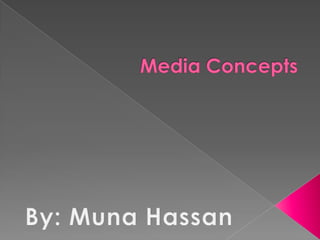
Media concepts
- 2. Audience Representation Narrative Media Language Genre
- 3. Audience Theories:1 Direct Effects Model: The media is seen as a hypodermic syringe This means that the contents of the media are injected into the thoughts of the audience The audience accept the attitudes, opinions and beliefs expressed by the medium without question What is wrong with this model? Read the following quotation and see how far would agree with it? “Audiences are not blank sheets of paper on which media messages can be written; members of an audience will have prior attitudes and beliefs which will determine how effective media messages are.”
- 4. Uses and Gratification Model: Four main needs that are satisfied by television: Can you sort them out Surveillance, Personal Identity, Diversion and Personal Relationships A form of escaping from the pressures of every day) The viewer gains companionship, either with the television characters, or through conversations with others about television. The viewer is able to compare their life with the lives of characters and situations on television The media are looked upon for a supply of information about what is happening in the world.
- 5. Reception Theory: Meanings were encoded by the producer into the media text, using codes and conventions and The audiences decode the meaning from the text. The audience‟s interpretation, decoding, is dependant on The socio/economic factors such as class, gender, age, education and ethnicity. The individual‟s past experiences and also previous knowledge and experience of the medium. There are four types of interpretations: preferred, negotiated, oppositional and aberrant
- 6. Representation is: The way in which ideas, objects, people, groups and life- forms are depicted by the mass media. Is the method used by the mass media to create meanings. Representations may be in speech or writing as well as still or moving pictures. Representation is unavoidably selective, foregrounding some things and backgrounding others. Representations which become familiar, through constant re-use, come to feel 'natural' and unmediated. Media representation can do one or more of three things: it can reinforce stereotypes it can challenge them it can inform them
- 7. The way in which a story is told in both fictional and “factual” media texts Narrative is defined as “a chain of events in a cause-effect relationship occurring in time”
- 8. Media texts are constructed using a creative language with its own rules, codes and conventions. Language can be video, audio or text (verbal or NVC) For example, scary music heightens fear, close ups convey intimacy, big headlines signal significance. It is argued that there is a difference between the story given to the viewer through the narrative and the story communicated to the audience through media language. For example, camerawork can often provide us with clues to the story that the narrative won‟t reveal until later. Similarly, print techniques, such as headlines, provide clues that the narrative will reveal later. All media texts address their intended audience in a particular way, establishing a relationship between the producer of the text and the media‟s audience. Understanding the grammar, syntax and metaphor system of media language, especially the language of sounds and visuals, which can reach beyond the rational to our deepest emotional core, is important It increases our appreciation and enjoyment of media experiences as well as helps us to be less susceptible to manipulation.
- 9. Genres may even function as a means of preventing a text from dissolving into 'individualism and incomprehensibility„ From the point of view of the producers of texts within a genre, an advantage of genres is that they can rely on readers already having knowledge and expectations about works within a genre. From the point of view of audiences, it helps them to choose the products which fulfil their interest and expectations In general discussions of television with children aged from 8- to 12-years-old, David Buckingham 1993, found 'considerable evidence of children using notions of genre, both explicitly and implicitly': Some critics suggest that 'readers learn genres gradually, usually through unconscious familiarization' Familiarity with a genre enables readers to generate feasible predictions about events in a narrative.